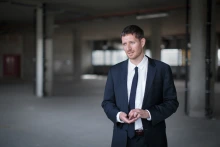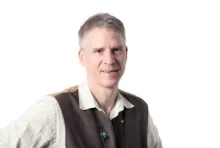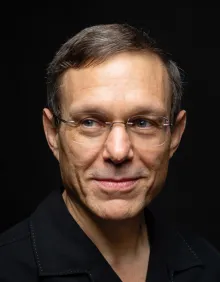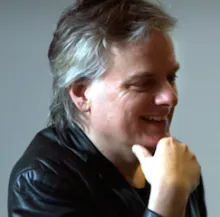Keynote Speakers
Robin Carhart-Harris, University of California San Francisco
PSYCHEDELICS

ROBIN CARHART-HARRIS, Ralph Metzner Distinguished Professor, Director of Neuroscape Psychedelics Division, Department of. Neurology, University of California, San Francisco
Robin Carhart-Harris moved to Imperial College London in 2008 after obtaining a PhD in Psychopharmacology from the University of Bristol, focused on the serotonin system, and an MA in Psychoanalysis from Brunel University, 2005. Robin has designed human brain imaging studies with LSD, psilocybin, MDMA and DMT, a clinical trial of psilocybin for treatment-resistant depression, a double-blind randomized controlled trial comparing psilocybin with the SSRI, escitalopram, for depression, published in the New England Journal of Medicine, and a multimodal imaging study in first time users of psilocybin. Robin has published over 100 scientific papers. He founded the Centre for Psychedelic Research at Imperial College London in April 2019, the first of its kind. In 2021, he was listed in TIME magazine’s ‘100 Next’, a list of 100 rising stars shaping the future. Also in 2021, he moved to University of California, San Francisco, becoming the Ralph Metzner Distinguished Professor in Neurology and Psychiatry. At UCSF, Robin will serve as Director of the new Psychedelics Division within the translational neuroscience Centre, Neuroscape.
Abstract Title: Psychedelics: Brain Mechanisms, Robin Carhart-Harris, UCSF
The talk takes a multi-level approach to the question of how psychedelics work in the brain. Key themes include: the pharmacology of classic serotonergic psychedelics, what this tells us about the current, developmental and evolutionary function of serotonin 2A receptor signaling, the acute brain effects of psychedelics as determined by functional brain imaging, current evidence for psychedelic therapy, the 'REBUS' model of the action of psychedelics, and how this maps on to the phenomenology of the acute psychedelic experience and therapeutic outcomes. The talk will end with a focus on a recent double-blind RCT comparing psilocybin therapy with an established antidepressant drug in the treatment of depression.
Christof Koch, Ph.D., Allen Institute for Brain Science
BRAIN CONSCIOUSNESS

CHRISTOF KOCH, Ph.D., Chief Scientist and President, Allen Institute for Brain Science, Seattle, Washington and Chief Scientist of the MindScope Program.
Christof received his baccalaureate from the Lycée Descartes in Rabat, Morocco, his B.S. and M.S. in physics from the University of Tübingen in Germany and his Ph.D. from the Max-Planck Institute for biological Cybernetics in 1982. Subsequently, he spent four years as a postdoctoral fellow in the Artificial Intelligence Laboratory and the Brain and Cognitive Sciences Department at the Massachusetts Institute of Technology. From 1987 until 2013, Koch was a professor at the California Institute of Technology (Caltech) in Pasadena, from his initial appointment as Assistant Professor, Division of Biology and Division of Engineering and Applied Sciences in 1986, to his final position as Lois and Victor Troendle Professor of Cognitive & Behavioral Biology. See here for Christof's academic pedigree and his students. Christof joined the Allen Institute for Brain Science as Chief Scientific Officer in 2011 and became President in 2015. Christof’s passion are neurons – the atoms of perception, memory, behavior and consciousness – their diverse shapes, electrical behaviors, and their computational function within the mammalian brain, in particular in neocortex. The Allen Institute for Brain Science is engaged in a major effort to identify all the different types of neurons in the brains of mice and humans – the cell census effort. See the papers below. Christof discovered that in vivo cortical neurons do not integrate over large number of small inputs given their spiking variability, how neurons can multiply, the relationship between intra- and extra-cellular potential, and how this gives rise to the local field potential and the large-scale current sinks and sources and how weak extracellular fields can entrain spiking activity via ephaptic effects. He postulated the attentional saliency map hypothesis for biological and computer vision according to which one or more topographic organized spatial maps summarize bottom-up salient information in the visual system, he co-discovered, with Itzhak Fried, an high-level, invariant and abstract single neuron representation of familiar individuals and objects in the human medial temporal lobe (the so-called “Jennifer Aniston” or concept neurons) and developed the ‘continuous flashed suppression’ masking technique. In collaboration with Francis Crick, he initiated the modern search for the neuronal correlates of consciousness, a systematic experimental program to identify the minimal bio-physical mechanisms jointly sufficient for any one specific conscious percept. In collaboration with Giulio Tononi, he co-developed the Integrated Information Theory of consciousness.
Abstract: Brain and Consciousness, Christof Koch, PhD, Mindscope Program, Allen Institute, Tiny Blue Dot Foundation
I will discuss what we can reasonably state about consciousness and its neuronal footprints in the mammalian brain, in particular the cortex, how to detect its presence and how psychedelics might affect these footprints
Avi Loeb, Harvard University
ASTROBIOLOGY AND ASTROCONSCIOUSNESS

ABRAHAM (AVI) LOEB is the Frank B. Baird, Jr., Professor of Science at Harvard University and a bestselling author (in lists of the New York Times, Wall Street Journal, Publishers Weekly, Die Zeit, Der Spiegel, L'Express and more).
Avi Loeb received a PhD in Physics from the Hebrew University of Jerusalem in Israel at age 24 (1980-1986), led the first international project supported by the Strategic Defense Initiative (1983-1988), and was subsequently a long-term member of the Institute for Advanced Study (1988-1993). Loeb has written 8 books, including most recently, Extraterrestrial (Houghton Mifflin Harcourt, 2021), and about 800 papers (with an h-index of 117) on a wide range of topics, including black holes, the first stars, the search for extraterrestrial life and the future of the Universe. Loeb is the head of the Galileo Project in search for extraterrestrial intelligence, the Director of the Institute for Theory and Computation (2007-present) within the Harvard-Smithsonian Center for Astrophysics , and also serves as the Head of the Galileo Project (2021-present). He had been the longest serving Chair of Harvard's Department of Astronomy (2011-2020) and the Founding Director of Harvard's Black Hole Initiative (2016-2021). He is an elected fellow of the American Academy of Arts & Sciences the American Physical Society, and the .International Academy of Astronautics. Loeb is a a former member of the President's Council of Advisors on Science and Technology (PCAST) at the White House, a former chair of the Board on Physics and Astronomy of the National Academies (2018-2021) and a current member of the Advisory Board for "Einstein: Visualize the Impossible" of the Hebrew University. He also chairs the Advisory Committee for the Breakthrough Starshot Initiative (2016-present) and serves as the Science Theory Director for all Initiatives of the Breakthrough Prize Foundation. In 2012, TIME magazine selected Loeb as one of the 25 most influential people in space and in 2020 Loeb was selected among the 14 most inspiring Israelis of the last decade. Click here for Loeb's commentaries on innovation and diversity. https://www.cfa.harvard.edu/~loeb/
Abstract Title: The Galileo Project: In Search for Technological Interstellar Objects - Avi Loeb, Professor of Science, Harvard University
The search for extraterrestrial life is one of the most exciting frontiers in science. First tentative clues were identified close to Earth in the form of the unusual interstellar object `Oumuamua and Unidentified Aerial Phenomena (UAP) in the Earth's atmosphere. The recently announced "Galileo Project" ushers the new frontier of "space archaeology" in search of extraterrestrial technological relics. The lecture will feature content from my book "Extraterrestrial", as well as the textbook "Life in the Cosmos", both published in 2021. Related material was also featured in my weekly commentaries in Scientific American and Medium.
David Chalmers, New York University
"REALITY+ : From the matrix to the metaverse".

DAVID CHALMERS
David Chalmers is University Professor of Philosophy and Neural Science and co-director of the Center for Mind, Brain, and Consciousness at New York University. He is the author of _The Conscious Mind_ (1996) and of Reality+: Virtual Worlds and the Problems of Philosophy (2022). He is known for formulating the “hard problem” of consciousness, for the idea of the “extended mind,” and for the thesis that virtual reality is genuine reality.
David Chalmers was featured in the New York Times Magazine, Dec. 10, 2021 - Interview with David Marchese - 'Can We Have a Meaningful Life in a Virtual World'
Reality+: Virtual Worlds and the Problems of Philosophy will be published by W.W. Norton (US) and Allen Lane (UK) on January 25, 2022. Here’s an excerpt.
Former Director, Center for Consciousness Studies, University of Arizona. Faculty positions included, UC Santa Cruz, University of Arizona, Australian National University. PhD, Philosophy and Cognitive Science, Indiana University; McDonnell Fellow at Washington University; Rhodes Scholar in Pure Maths and Computer Science at the University of Adelaide in Australia. David Chalmers is Co-Founder, Center for Consciousness Studies, Tucson. Chalmers’s writings include: Philosophy of Mind; The Conscious Mind; The Character of Consciousness; Constructing the World; Mind and Consciousness; Facing Up to the Problem of Consciousness.
DAVID CHALMERS WEBSITE http://consc.net/
David Chalmers, Professor of Philosophy and Neural Science, New York University
I'll argue that virtual reality is genuine reality. A simulated universe such as the Matrix could be indistinguishable from physical reality. Such a reality need not be illusory. The same goes for the Metaverse: the virtual worlds that we will create in coming decades with virtual and augmented reality technology. I will argue that Metaverse-style virtual worlds are genuine realities, and that we can live a meaningful life in these virtual worlds.

